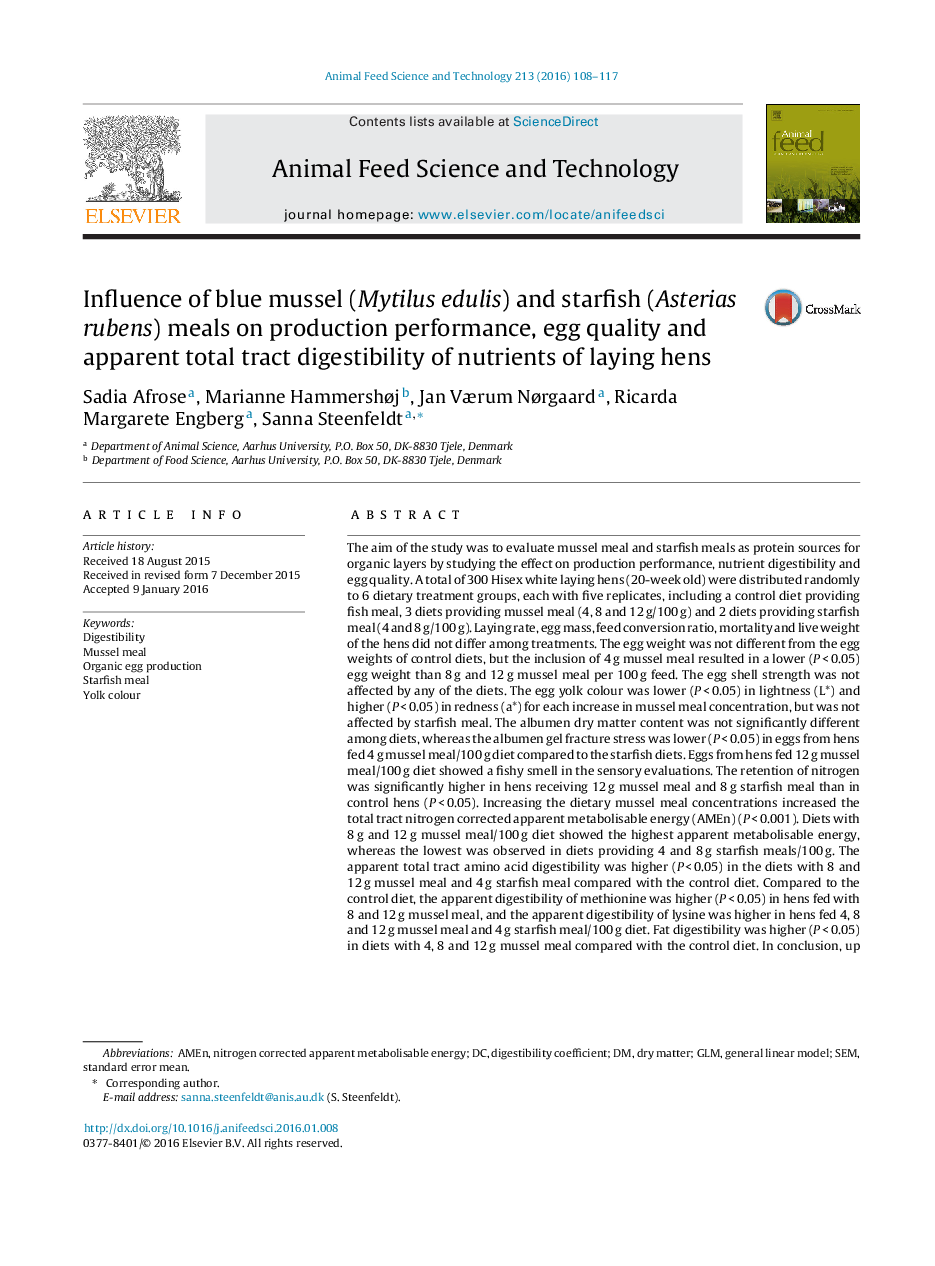| کد مقاله | کد نشریه | سال انتشار | مقاله انگلیسی | نسخه تمام متن |
|---|---|---|---|---|
| 2419355 | 1552372 | 2016 | 10 صفحه PDF | دانلود رایگان |

• Mussel and starfish are both rich in protein and essential amino acids.
• Influence on production performance, nutrient digestibility and egg quality was evaluated.
• Up to 8% starfish and 12% mussel meal have positive effect on production.
• Egg yolk colour improved significantly by adding mussel meal.
• Contribute with dietary protein that is comparable to fish meal.
The aim of the study was to evaluate mussel meal and starfish meals as protein sources for organic layers by studying the effect on production performance, nutrient digestibility and egg quality. A total of 300 Hisex white laying hens (20-week old) were distributed randomly to 6 dietary treatment groups, each with five replicates, including a control diet providing fish meal, 3 diets providing mussel meal (4, 8 and 12 g/100 g) and 2 diets providing starfish meal (4 and 8 g/100 g). Laying rate, egg mass, feed conversion ratio, mortality and live weight of the hens did not differ among treatments. The egg weight was not different from the egg weights of control diets, but the inclusion of 4 g mussel meal resulted in a lower (P < 0.05) egg weight than 8 g and 12 g mussel meal per 100 g feed. The egg shell strength was not affected by any of the diets. The egg yolk colour was lower (P < 0.05) in lightness (L*) and higher (P < 0.05) in redness (a*) for each increase in mussel meal concentration, but was not affected by starfish meal. The albumen dry matter content was not significantly different among diets, whereas the albumen gel fracture stress was lower (P < 0.05) in eggs from hens fed 4 g mussel meal/100 g diet compared to the starfish diets. Eggs from hens fed 12 g mussel meal/100 g diet showed a fishy smell in the sensory evaluations. The retention of nitrogen was significantly higher in hens receiving 12 g mussel meal and 8 g starfish meal than in control hens (P < 0.05). Increasing the dietary mussel meal concentrations increased the total tract nitrogen corrected apparent metabolisable energy (AMEn) (P < 0.001). Diets with 8 g and 12 g mussel meal/100 g diet showed the highest apparent metabolisable energy, whereas the lowest was observed in diets providing 4 and 8 g starfish meals/100 g. The apparent total tract amino acid digestibility was higher (P < 0.05) in the diets with 8 and 12 g mussel meal and 4 g starfish meal compared with the control diet. Compared to the control diet, the apparent digestibility of methionine was higher (P < 0.05) in hens fed with 8 and 12 g mussel meal, and the apparent digestibility of lysine was higher in hens fed 4, 8 and 12 g mussel meal and 4 g starfish meal/100 g diet. Fat digestibility was higher (P < 0.05) in diets with 4, 8 and 12 g mussel meal compared with the control diet. In conclusion, up to 8 g mussel meal and starfish meal per 100 g feed can be used in diets as a high quality protein source for egg production. These meals can replace fish meal; however, an inclusion level higher than 8 g/100 g of mussel or starfish meal may result in a fishy smell of the eggs.
Journal: Animal Feed Science and Technology - Volume 213, March 2016, Pages 108–117